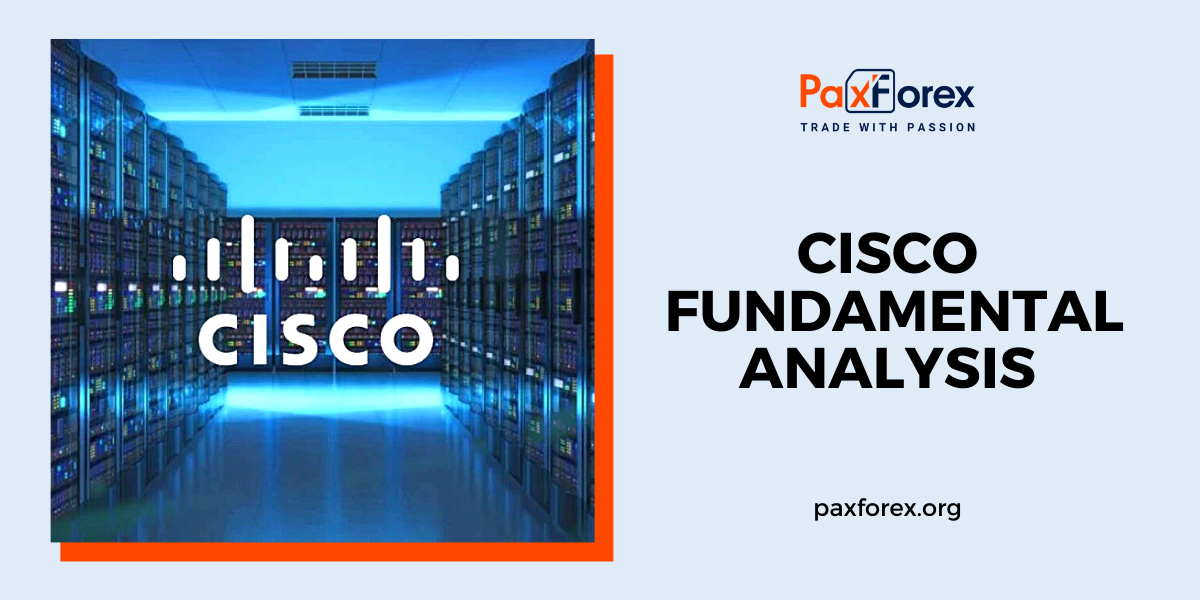
Source: PaxForex Premium Analytics Portal, Fundamental Insight
In 2023, many technology stocks experienced a rebound from the previous year's significant downturn, and Cisco Systems, a veteran in Silicon Valley, was no exception. The stock reached a 52-week high of $58.19 on September 1. However, in mid-November, Cisco's shares took a hit following the release of its earnings for the fiscal first quarter, which concluded on October 28. Investors seemed to react to something in the earnings report, sparking a notable decline.
For those seeking potential bargains, the critical question is whether the factors leading to the sell-off are enduring, long-term issues or temporary challenges that are likely to resolve over time. Let's delve into the details to gain clarity.
Interestingly, Cisco actually delivered impressive results in the latest quarter, marking the strongest Q1 in the company's history in terms of revenue and profit. Sales experienced an 8% year-over-year increase, reaching $14.7 billion, while net income surged by 36% to $3.6 billion. The company successfully addressed pent-up demand that had been previously unmet due to supply chain constraints.
Furthermore, Cisco's balance sheet demonstrated strength. At the end of the quarter, the company's assets amounted to $98.8 billion, compared to $53.6 billion in liabilities. Additionally, Cisco held $23.5 billion in cash, cash equivalents, and investments.
The decline in Cisco's stock, despite posting remarkable results, can be attributed to management's cautionary note about the observed signs indicating a slowdown in the surge of demand, particularly a 20% decline in product orders during the quarter.
In response to this, the company provided revenue guidance for its fiscal Q2, anticipating at least $12.6 billion, a notable decrease from the previous year's $13.6 billion. Additionally, management forewarned that the period of diminished customer demand might extend for a few more quarters before returning to normal levels. This cautious near-term outlook prompted the sell-off of Cisco stock.
For investors with a long-term perspective, it's crucial to recognize that this short-term challenge is expected to subside eventually, paving the way for the stock to recover. A key factor instilling confidence in Cisco's ability to rebound is its software business.
While Cisco initially gained prominence as a computer networking company, it has successfully diversified with a substantial portfolio of software offerings, encompassing IT systems monitoring and cybersecurity. This strategic move allows the company to generate predictable recurring revenue through software-as-a-service (SaaS) subscriptions. Unlike its hardware business, the SaaS segment is less sensitive to cyclical market fluctuations.
Cisco's software-as-a-service (SaaS) offerings are poised to strengthen further following its planned acquisition of cybersecurity analytics firm Splunk in 2024. The addition of Splunk's solutions will complement Cisco's cybersecurity product suite, enhancing its capabilities.
Splunk, which experienced year-over-year growth in revenue, net income, and free cash flow in its fiscal third quarter ending Oct. 31, brings a thriving business with $1.1 billion in fiscal Q3 sales. This additional revenue is expected to contribute positively to Cisco's top line in the coming year.
Particularly appealing to income investors, Splunk's robust free cash flow growth will support Cisco's ability to sustain its dividend, which currently yields over 3% based on the current share price. With a track record of raising payouts for 13 consecutive years, Cisco's dependable dividend provides long-term investors with a consistent income stream while waiting for the stock to recover.
Considering the recent drop in Cisco's share price, this presents an opportune time for long-term investors to acquire the stock. Cisco's business outlook is set to improve further with the completion of the Splunk acquisition and the anticipated rebound in sales after the current cyclical downturn.
In the interim, investors can benefit from Cisco's reliable dividend, making it an attractive income stock. These factors collectively position Cisco as a compelling investment for the long haul.
As long as the price is above 50.00, follow the recommendations below:
- Time frame: D1
- Recommendation: long position
- Entry point: 51.82
- Take Profit 1: 54.00
- Take Profit 2: 56.00
Alternative scenario:
If the level of 50.00 is broken-down, follow the recommendations below:
- Time frame: D1
- Recommendation: short position
- Entry point: 50.00
- Take profit 1: 48.00
- Take Profit 2: 46.00













